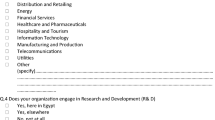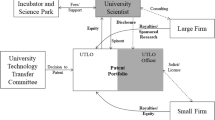Abstract
Over the last 20 years, universities have made steady progress in their efforts to foster the process of technology transfer through collaboration with industry. The establishment of technology transfer offices (TTO) has become routine for supporting the commercialization of academic research. However, the literature shows that there are many factors that affect the efficiency and effectiveness of these offices. Based on original data from interviews with 197 university departments in Italy, this paper investigates the determinants of universities university use of TTOs. We take account of the effects of universities’ and TTOs characteristics, of research and geographic indicators.
Similar content being viewed by others
Notes
See Landry et al. (2007) for an overview.
See, e.g., the results of the UK HE-BCI survey or Muscio (2008).
For, e.g., the two national laws D.L. 27/7/1999 no. 297 and D.M. 8/8/2000 no. 593 encourage and regulate the creation of university TTOs. Art. 65 of the Codice dei Diritti di Proprietà Industriale, 10/02/2005, introduced Bayh-Dole act-like regulation of intellectual property, granting intellectual property rights to scientists for their scientific discoveries. You took out qualification of the acro IPR in the text so either it must be reinstated or you must establish it in the footnote so that you continue to use the short form in the fn or spell out in footnotes as well, which would be more consistent.
The survey was carried out by Gruppo di Ricerche Industriali e Finanziarie (GRIF)—Università Luiss Guido Carli (Roma) as part of the research project “The Governance of Technology Transfer in Italy”, funded by the Italian Ministry of University and Research (MIUR), Progetto FIRB: “A Multidimensional Approach to Technology Transfer”.
The National University Council (CUN) classification of scientific areas is similar to that applied by the OECD in its Frascati Manual (OECD 2002). The scientific areas considered here correspond to the areas identified by the Frascati Manual as: (1) Natural Sciences, (2) Engineering & Technology, (3) Medical Sciences, (4) Agricultural Sciences.
The list of departments is available at: www.cineca.it. Contact details were found for 1,047 out of 1,116 department directors.
This is supported by the results of the econometric analysis: estimates were similar with and without population weighting.
Apart from Industrial Engineering, where there is around one collaboration per research staff member.
In 2005 CIVR conducted the Valutazione Triennale della Ricerca (VTR), the first national evaluation of research activity in Italy, covering 2001–2003 (MIUR 2007). The review targeted the research performance of all universities and public research centres. The 102 research institutions involved in the review submitted a predefined number of research outputs (books, book chapters, journal articles, patents and other types of economic valorization of research results, manufactured and artistic products) to an expert panel for peer review. The number of research outputs per institution was defined based on university size (full-time-equivalent research staff). The VTR rated and ranked university research performance and assessed the impact factor of outputs.
Provinces correspond to NUTS 3 units in the Eurostat classification of administrative units in Europe. The average dimension of an Italian province is 2,926.6 km2. The data refer to the 2001 Census carried out by ISTAT.
Chapple et al. (2005) suggest that in these geographical contexts, government should establish regional TTOs to offer additional assistance to both universities and businesses.
Jensen and Thursby (2001) in their study on university licensing found that the majority of licensed technologies are not ready for commercialization and require significant development to turn them into commercial products.
References
Arnold, E., Brown, N., Eriksson, A., Jansson, T., Muscio, A., Nählinder, J., & Zaman, R. (2006). The Role of industrial research institutes in the national innovation system: A report to VINNOVA, Technopolis, October.
Arora, A., Fosfuri, A., & Gambardella, A. (2002). Markets for technology—The economics of innovation and corporate strategy. Cambridge: MIT Press.
Bozeman, B. (2000). Technology transfer and public policy: A review of research and theory. Research Policy, 29, 627–655.
Bozeman, B., Papadakis, M., & Coker, K. (1995). Industry perspectives on commercial interactions with federal laboratories: Does the cooperative technology paradigm really work? Report to the National Science Foundation. Research on Science and Technology Program.
Branscomb, L. M., Kodama, F., & Richard, F. (1999). Industrializing knowledge: University–industry linkages in Japan and the United States. London: MIT Press.
Branstetter, L., & Ogura, Y. (2005). Is academic science driving a surge in industrial innovation? Evidence from patent citation. National Bureau of Economic Research, NBER Working Paper 11561, August.
Breschi, S., Lissoni, F., & Montobbio, F. (2007). The scientific productivity of academic inventors: New evidence from Italian data. Economics of Innovation and New Technology, 16(2), 101–118.
Chapple, W., Lockett, A., Siegel, D., & Wright, M. (2005). Assessing the relative performance of UK university technology transfer offices: Parametric and non-parametric evidence. Research Policy, 34, 369–384.
Cohen, W. M., Florida, R., Randazzese, L., & Walsh, J. (1998). Industry and the academy: Uneasy partners in the cause of technological advance. In R. G. Noll (Ed.), Challenges to research universities (pp. 171–200). Washington, DC: The Brookings Institution. (ch. 7).
Colyvas, J., Crow, M., Gelijns, A., Mazzoleni, R., Nelson, R. R., Rosenberg, N., et al. (2002). How do university inventions get into practice? Management Science, 48(1), 61–72.
Coupé, T. (2003). Science is golden: Academic R&D and university patents. Journal of Technology Transfer, 28, 31–46.
D’Este, P., Nesta, L., & Patel, P. (2005). Analysis of university–industry research collaborations in the UK: Preliminary results of a survey of university researchers. SPRU Report for a project funded by EPSRC/ESRC.
D’Este, P., & Patel, P. (2007). University–industry linkages in the UK: What are the factors underlying the variety of interactions with industry? Research Policy, 36, 1295–1313.
Etzkowitz, H. (1998). The norms of entrepreneurial science: Cognitive effects of the new university–industry linkages. Research Policy, 27, 823–833.
Fisher, D., & Atkinson-Grosjean, J. (2002). Brokers on the boundary: Academy-industry liaison in Canadian universities. Higher Education, 44, 449–467.
Friedman, J., & Silberman, J. (2003). University technology transfer: Do incentives, management, and location matter? Journal of Technology Transfer, 28, 17–30.
Geuna, A., & Muscio, A. (2008). The governance of university knowledge transfer. SPRU Electronic Working Paper Series, September, SEWP173.
Grant, E. B., & Gregory, M. J. (1997). Tacit knowledge, the life cycle and international manufacturing transfer. Technology Analysis and Strategic Management, 9(2), 149–161.
Guldbrandsen, M., & Smeby, J. C. (2005). Industry funding and university professors’ research performance. Research Policy, 34, 932–950.
Hackett, S., & Dills, D. (2004). A systematic review of business incubation research. Journal of Technology Transfer, 29(1), 55–82.
Hatakenaka, S. (2006). Development of third stream activity: Lessons from international experience. Oxford: Higher Education Policy Institute.
Hollanders, H., & Celikel Esser F. (2007). Measuring innovation efficiency. INNO-Metrics Thematic, December.
IPI—Istituto per la Promozione Industriale. (2005). Indagine sui centri per l’innovazione e il trasferimento tecnologico in Italia, a cura del Dipartimento Centri e Reti Italia, Direzione Trasferimento di Conoscenza e Innovazione, Novembre, Roma.
Jensen, R., & Thursby, M. (2001). Proofs and prototypes for sale: The tale of university licensing. American Economic Review, 91(1), 240–259.
Jensen, R. A., Thursby, J. G., & Thursby, M. C. (2003). The disclosure and licensing of university inventions: The best we can do with the s**t we get to work with. International Journal of Industrial Organization, 21(9), 1271–1300.
Lambert, R. (2003). Lambert review of business–university collaboration: Final report. HM Treasury, December.
Landry, R., Amara, N., & Ouimet, M. (2007). Determinants of knowledge transfer: Evidence from Canadian university researchers in natural sciences and engineering. Journal of Technology Transfer, 32, 561–592.
Link, N., & Scott, J. T. (2007). The economics of university research parks. Oxford Review of Economic Policy, 23(4), 620–639.
Litan, R. E., Mitchell, L., & Reedy, E. J. (2007). Commercializing university innovations: Alternative approaches. Available at SSRN: http://ssrn.com/abstract=976005
Lowe, R. A. (2006). Who develops a university invention? The impact of tacit knowledge and licensing policies. Journal of Technology Transfer, 31, 415–429.
Mansfield, E. (1995). Academic research underlying industrial innovation: Sources characteristics and financing. Review of Economics and Statistics, 77, 55–65.
Mansfield, E. (1998). Academic research and industrial innovation: An update of empirical findings. Research Policy, 26, 773–776.
Markman, G. D., Gianiodis, P. T., Phan, P. H., & Balkin, D. B. (2005a). Innovation speed: Transferring university technology to market. Research Policy, 34, 1058–1075.
Markman, G. D., Phan, P. H., Balkin, D. B., & Gianiodis, P. T. (2005b). Entrepreneurship and university-based technology transfer. Journal of Business Venturing, 20(2), 241–263.
Marsili, O., & Verspagen, B. (2002). Technology and the dynamics of industrial structure: An empirical mapping of Dutch manufacturing. Industrial and Corporate Change, 11(4), 791–815.
MIUR—Ministero dell’Università e della Ricerca. (2007). CIVR, Comitato per la Valutazione della Ricerca, VTR 2001–2003, Relazione Finale, Roma.
Muscio, A. (2008). Il trasferimento tecnologico in Italia: risultati di un’indagine sui dipartimenti universitari. L’Industria Numero Speciale, pp. 245–268.
Nooteboom, B., van Haverbeke, W., Duysters, G., Gilsing, V., & van den Oord, A. (2007). Optimal cognitive distance and absorptive capacity. Research Policy, 36, 1016–1034.
O’Gorman, C., Byrne, O., & Pandya, D. (2008). How scientists commercialise new knowledge via entrepreneurship. Journal of Technology Transfer, 33, 23–43.
OECD. (2002). Frascati manual: Proposed standard practice for surveys on research and experimental development. Paris: OECD.
OECD. (2003). Turning science into business: Patenting and licensing at public research organisations. Paris: OECD.
Owen-Smith, J., & Powell, W. W. (2001). To patent or not: Faculty decisions and institutional success at technology transfer. Journal of Technology Transfer, 26, 99–114.
Pavitt, K. (1984). Sectoral patterns of technical change: Towards a taxonomy and a theory. Research Policy, 13, 353–369.
Piccaluga, A., & Balderi, C. (2006). La valorizzazione della ricerca nelle università italiane, Quarto rapporto annuale (dati relativi al periodo 2002–2005). Netval.
Rothaermel, F. T., Agung, S., & Jiang, L. (2007). University entrepreneurship: A taxonomy of the literature. Industrial and Corporate Change, 16(4), 691–791.
Siegel, D. S., Veugelers, R., & Wright, M. (2007). Technology transfer offices and commercialization of university intellectual property: Performance and policy implications. Oxford Review of Economic Policy, 23(4), 640–660.
Siegel, D. S., Waldman, D., Atwater, L., & Link, A. N. (2004). Toward a model of the effective transfer of scientific knowledge from academicians to practitioners: Qualitative evidence from the commercialization of university technologies. Journal of Engineering and Technology Management, 21(1–2), 115–142.
Siegel, D. S., Waldman, D., & Link, A. (2003). Assessing the impact of organizational practices on the relative productivity of university technology transfer offices: An exploratory study. Research Policy, 32, 27–48.
Sloman, R. G. (2007). Technology transfer data management. In intellectual property management. In A. Krattiger, R. T. Mahoney, L. Nelsen, et al. (Eds.) Health and agricultural innovation: A handbook of best practices. Oxford, UK: MIHR, and Davis, California, USA: PIPRA. Available at http://www.ipHandbook.org
Acknowledgments
This work benefited from valuable comments from Francesco Crespi, Jean-Michel Dalle, Francesco Ferrante, Aldo Geuna, Georg Licht, Francesco Lissoni, Mauro Mallone, Laura Ramaciotti and two anonymous referees. The author would like to acknowledge the financial support of the Italian Ministry of University and Research (FIRB Project 2003—Prot. RBNE033K2R: “A multidimensional approach to technology transfer for more efficient organizational models”). Finally the author is grateful to the late Professor Fabio Gobbo for his guidance and encouragement throughout this work.
Author information
Authors and Affiliations
Corresponding author
Rights and permissions
About this article
Cite this article
Muscio, A. What drives the university use of technology transfer offices? Evidence from Italy. J Technol Transf 35, 181–202 (2010). https://doi.org/10.1007/s10961-009-9121-7
Published:
Issue Date:
DOI: https://doi.org/10.1007/s10961-009-9121-7




